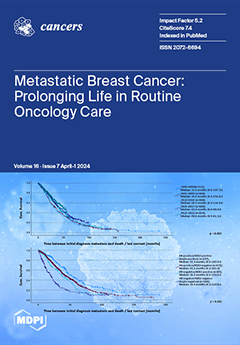Background: (4
S)-4-(3-[
18F]fluoropropyl)-L-glutamic acid ([
18F]FSPG) positron emission tomography/computed tomography (PET/CT) provides a readout of system x
c− transport activity and has been used for cancer detection in clinical studies of different cancer types. As system x
c− provides the rate-limiting precursor for glutathione biosynthesis, an abundant antioxidant, [
18F]FSPG imaging may additionally provide important prognostic information. Here, we performed an analysis of [
18F]FSPG radiotracer distribution between primary tumors, metastases, and normal organs from cancer patients. We further assessed the heterogeneity of [
18F]FSPG retention between cancer types, and between and within individuals. Methods: This retrospective analysis of prospectively collected data compared [
18F]FSPG PET/CT in subjects with head and neck squamous cell cancer (HNSCC,
n = 5) and non-small-cell lung cancer (NSCLC,
n = 10), scanned at different institutions. Using semi-automated regions of interest drawn around tumors and metastases, the maximum standardized uptake value (SUV
max), SUV
mean, SUV standard deviation and SUV
peak were measured. [
18F]FSPG time–activity curves (TACs) for normal organs, primary tumors and metastases were subsequently compared to
18F-2-fluoro-2-deoxy-D-glucose ([
18F]FDG) PET/CT at 60 min post injection (p.i.). Results: The mean administered activity of [
18F]FSPG was 309.3 ± 9.1 MBq in subjects with NSCLC and 285.1 ± 11.3 MBq in those with HNSCC. The biodistribution of [
18F]FSPG in both cohorts showed similar TACs in healthy organs from cancer patients. There was no statistically significant overall difference in the average SUV
max of tumor lesions at 60 min p.i. for NSCLC (8.1 ± 7.1) compared to HNSCC (6.0 ± 4.1;
p = 0.29) for [
18F]FSPG. However, there was heterogeneous retention between and within cancer types; the SUV
max at 60 min p.i. ranged from 1.4 to 23.7 in NSCLC and 3.1–12.1 in HNSCC. Conclusion: [
18F]FSPG PET/CT imaging from both NSCLC and HNSCC cohorts showed the same normal-tissue biodistribution, but marked tumor heterogeneity across subjects and between lesions. Despite rapid elimination through the urinary tract and low normal-background tissue retention, the diagnostic potential of [
18F]FSPG was limited by variability in tumor retention. As [
18F]FSPG retention is mediated by the tumor’s antioxidant capacity and response to oxidative stress, this heterogeneity may provide important insights into an individual tumor’s response or resistance to therapy.
Full article






